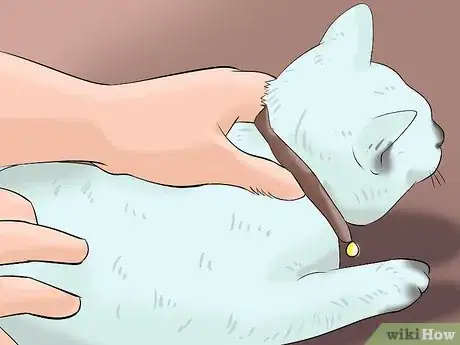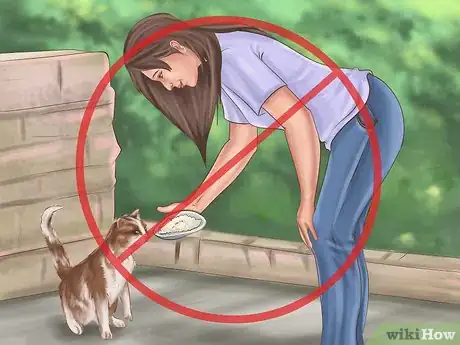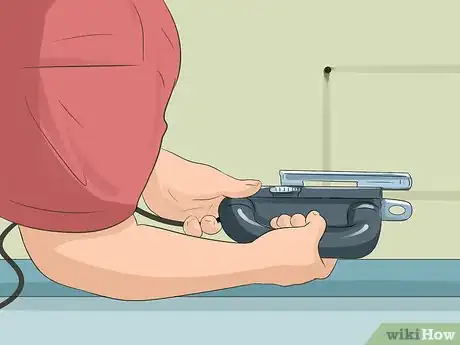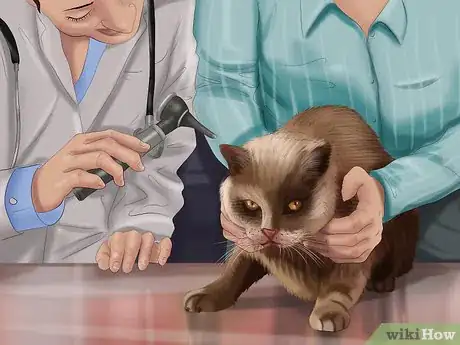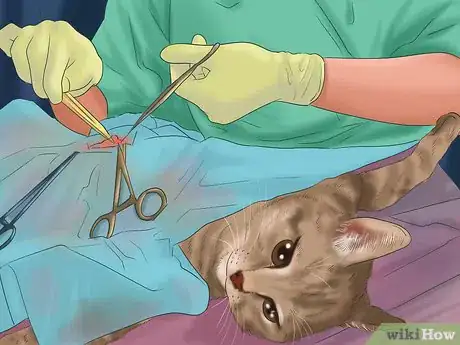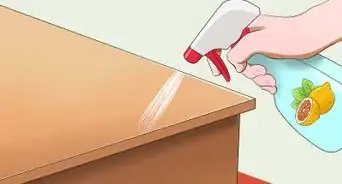This article was co-authored by Pippa Elliott, MRCVS. Dr. Elliott, BVMS, MRCVS is a veterinarian with over 30 years of experience in veterinary surgery and companion animal practice. She graduated from the University of Glasgow in 1987 with a degree in veterinary medicine and surgery. She has worked at the same animal clinic in her hometown for over 20 years.
There are 14 references cited in this article, which can be found at the bottom of the page.
This article has been viewed 108,693 times.
If left uncontrolled, stray cats can breed and develop into large feral colonies, especially in rural areas. They can carry diseases and parasites, kill birds vital for keeping down destructive insect populations, and may even chase away your own pet cats if you allow them outside. Property owners may be fined by local governments for not handling cat problems.
Steps
Making Sure the Cat is Stray
-
1Ask your neighbors. Make every effort to make sure the cat doesn't have an owner. Outdoor cats establish their own territories that likely include other people's properties, so just because you see them often doesn't mean they don't already have a home. Ask your neighbors if the cat is theirs or if they know whose cat it is.
-
2Look for a collar. Before you take an action with a cat you think is stray, check to make sure whether or not they have a collar. If there is a collar, contact the owner to discuss whatever is bothering you about the cat.Advertisement
-
3Make fliers. If a cat is causing you problems, post signs in your neighborhood to give warning to the potential owner that you may take action. This allows the owner time to remedy the situation. Include a picture of the cat on the flier and your contact information.[1]
-
4Make an online profile for a lost pet. There are many online resources to help reunite lost pets with their owners. Consider making a profile for the cat you are concerned about and see if someone claims it. The Center for Lost Pets is a great choice for this and recommended by the Humane Society.[2]
-
5Ask the vet to check for a microchip. Once you trap the cat (see below), you can take it to a veterinarian to see if the cat has a microchip implant. Most household pet cats receive microchip implants at their vet appointments. A vet can scan the cat to see if there is a microchip which will direct you to its owner.[3]
-
6Think about your desired outcome. Realize that most cats taken to animal shelters are not adopted and are therefore euthanized, so see if you'd like to keep any of the strays. A limited number of cats can be useful for catching gophers, rats, and mice, even if they won't make suitable pets.
- Be sure to have such cats tested for feline immunodeficiency virus (FIV, aka feline AIDS) and feline leukemia virus (FeLV), vaccinated, and altered. You don't want your "limited number" to become a mob.
- If any of the cats test positive for FIV or FeLV, for the good of all the cats in the neighborhood, you must have a veterinarian humanely put them down, unless you are able and willing to adopt such cats and keep them inside only.[4] [5]
- If you own uninfected cats, this is not a viable option, since no cure exists for either disease. (Note: humans cannot catch either of these feline-specific diseases.)
Minimizing a Stray Cat’s Impact
-
1Don’t feed a stray cat. Stray cats will continue to frequent locations where food is easily accessible or provided for them directly. Over time, more and more cats will begin to show up for the food you are putting out. This means that you’ll have a large group of stray cats hanging around who will often fight each other for the food, spread diseases among themselves, and breed right in your backyard. [6]
-
2Take precautions around your property. To minimize the likelihood of a stray cat remaining on or near your property, take every precaution you can to make your property unappealing to stray or feral cats. The more proactive you are about cleaning up your property, the less likely it will be that stray cats to hang out there.
- One thing this means is decluttering – removing brush and debris, old cars or other machinery, or anything else that may be cluttering up your property and providing nice hiding places for stray cats.
- You should also seal up any outside holes in your home or that allow access into any outdoor buildings. Replace broken windows and seal any damaged surface holes.
-
3Protecting your own pets. Keep your house pets indoors when possible. But if you must let them outside, make sure they always have collars on to differentiate them from the stray cats in your neighborhood. You don’t want people trapping your cat because they think it is a stray cat too.
Trapping the Stray Cat
-
1Get a trap. Rent or purchase a humane cat trap at your local hardware or pet store; most can be bought for around fifty dollars. Animal shelters may also have them to loan or rent. Such metal traps have doors that spring closed when cats step on the metal trigger inside, while providing the least possible distress and injury.[7] [8]
- Make sure the container doesn't have any sharp edges that could injure the cat.
- You can put down a small towel or piece of cloth inside the trap to make the trap more comfortable. But remember that animals have great senses of smell, so using the same towel over and over will actually repel the cats.
-
2Position the trap. Keep one door shut if there are doors on either end, so larger cats must enter the trap completely. Place wet cat food, chicken, tuna, or liver behind the trigger pad so the cat has to walk over the trigger pad to get to the food.[9]
- Position the trap under a roof so cats do not remain in heat or rain once caged. Never leave a trap unattended.
- If the cat will be in the trap for longer than 12 hours provide a plastic container of water so they don't get thirsty. Use tie wraps to secure this in place so they don't knock it over trying to escape once trapped.
- This should only happen if you have to wait to take the animal to the vet clinic, or when you are caring for the cat after it has been spayed or neutered. Otherwise, try to get the cat in and out of the trap as quickly as possible.
-
3Use the proper precautions. Monitor the trap closely to see if you have caught a stray cat. You don’t want a cat stuck in there for too long. The point of trapping the cat is to give it a better life and a better chance of survival in the most humane way possible.
- Don’t ever leave the trap unattended. Anything could happen while you’re away. Once you set the trap up, back away, but always stay within sight of the trap.[10]
- Place a blanket over the cage. This helps calm cats and reduces trauma.
- Wear heavy gloves when handling traps to avoid serious infections if you scratch yourself on the metal cage, or if you are scratched by a cat during transport. A cat can bite through surprisingly heavy material if panicked.
- Place traps on plastic bags or tarps to contain cat waste, especially if transporting in a car.
-
4Clean the trap for reuse when you are done. Clean and spray the traps down before using again when it is empty. You can use any kind of disinfectant spray and a rag.
Getting the Stray Cat Spayed or Neutered
-
1Take the stray cat to the vet. Take the stray cat to the vet as soon as possible if it has been caught, leaving the blanket on the trap. If transporting in a truck, secure the trap with bungee cords so it doesn't slide around or tip over.
- The vet can check for a microchip too.
-
2Search for low cost spay/neuter options for feral cats. Most communities have a variety of options to meet this need.[11] [12] Set up the appointment before you trap the cat so you don’t have to keep it trapped longer than necessary.
- Try asking your local veterinarian if they know of any low cost spay/neuter options. Sometimes vets themselves offer clinics for this purpose. If not, they should be able to direct you to a local rescue group, shelter, humane society, or other organization that offers this type of service.
- Make sure the cat gets an eartip to identify it as spayed.[13]
-
3Care for the cat after the vet visit. Have it spayed or neutered, ear tipped, and given a rabies shot. Feral cats may react differently than house cats, so it is okay to leave a feral stray cat in its trap/cage for a day or two after the surgery.[14]
Warnings
- Never try to poison, shoot, or otherwise harm a stray cat. Not only is it cruel and inhumane, but many states and localities have laws with stiff penalties against such animal cruelty.⧼thumbs_response⧽
- If you have a cat, have it spayed or neutered as soon as it is old enough for the procedure – usually around 8 weeks. One of the reasons so many stray cats and feral colonies exist is that irresponsible cat owners let their cats breed. Even if a cat owner is able to find homes for the kittens, those kittens may grow up and reproduce. That will mean more cats will face euthanasia or add to the stray cat problem due to lack of homes.⧼thumbs_response⧽
Things You'll Need
- Humane trap
- Roofed trap area
- Cat food
- Water container
- Trap blanket
- Ties and cords
- Suitable transport vehicle
- Funds for shelter donations or vet costs
References
- ↑ http://www.humanesociety.org/issues/feral_cats/tips/help_outdoor_cats_individuals.html?credit=web_id212453451
- ↑ http://www.thecenterforlostpets.com/
- ↑ http://www.humanesociety.org/issues/feral_cats/tips/help_outdoor_cats_individuals.html?credit=web_id212453451
- ↑ https://www.vet.cornell.edu/departments-centers-and-institutes/cornell-feline-health-center/health-information/feline-health-topics/feline-immunodeficiency-virus
- ↑ https://www.vet.cornell.edu/departments-centers-and-institutes/cornell-feline-health-center/health-information/feline-health-topics/feline-leukemia-virus
- ↑ http://www.aaanimalcontrol.com/professional-trapper/feed-stray-cats.html
- ↑ http://www.peta.org/living/companion-animals/feral-cats/
- ↑ http://www.alleycat.org/Trap-Neuter-Return
- ↑ https://www.petfinder.com/helping-pets/feral-cats/caring-for-feral-cats/
About This Article
To control stray cats around your home, try to make your property as uninviting as possible by clearing away any brush and debris that cats like to hide under. You should also avoid leaving out any food and water, since it could attract more stray cats to your home. If the cats still stick around, you might want to post fliers around your neighborhood and put up an ad online with pictures to see if anyone is missing a cat. Alternatively, you can catch the cats using live traps and take them to a vet, where they'll be scanned for microchips and reunited with their owner if they have one. Even if they don't have an owner, you might be able to get the cats fixed for free or at a low cost to help keep the stray population down once you release them. For tips on how to take a stray cat into your home and adopt it, keep reading!

